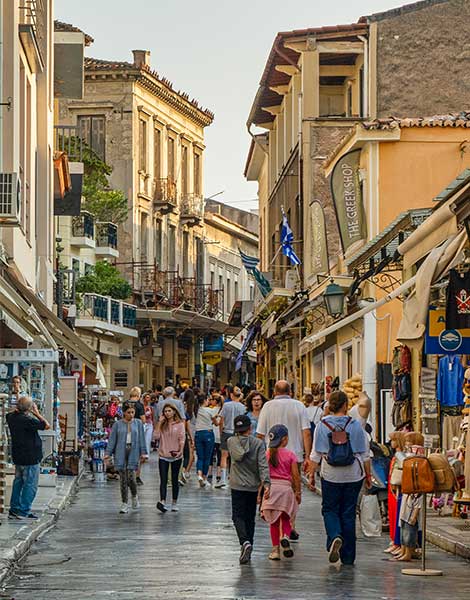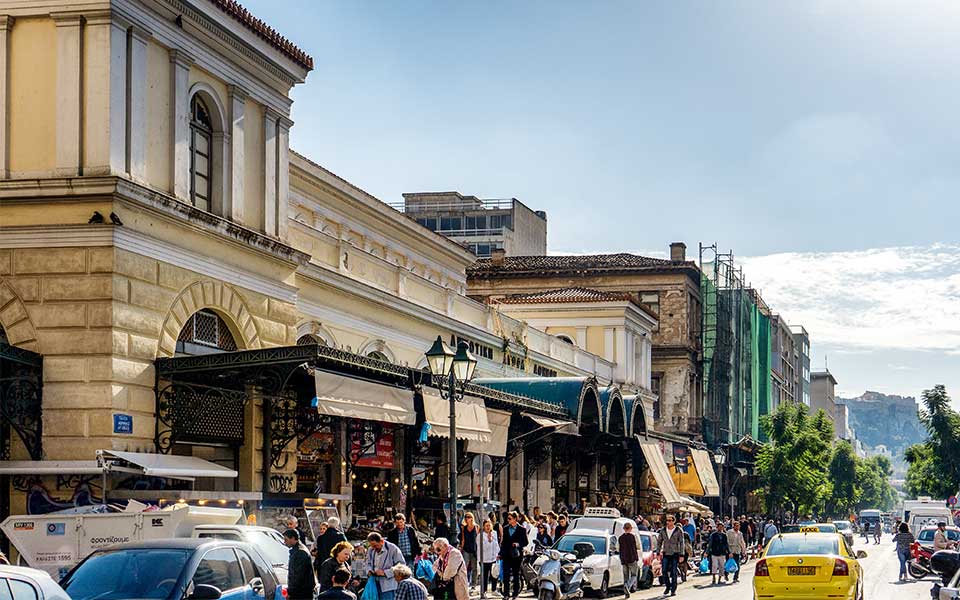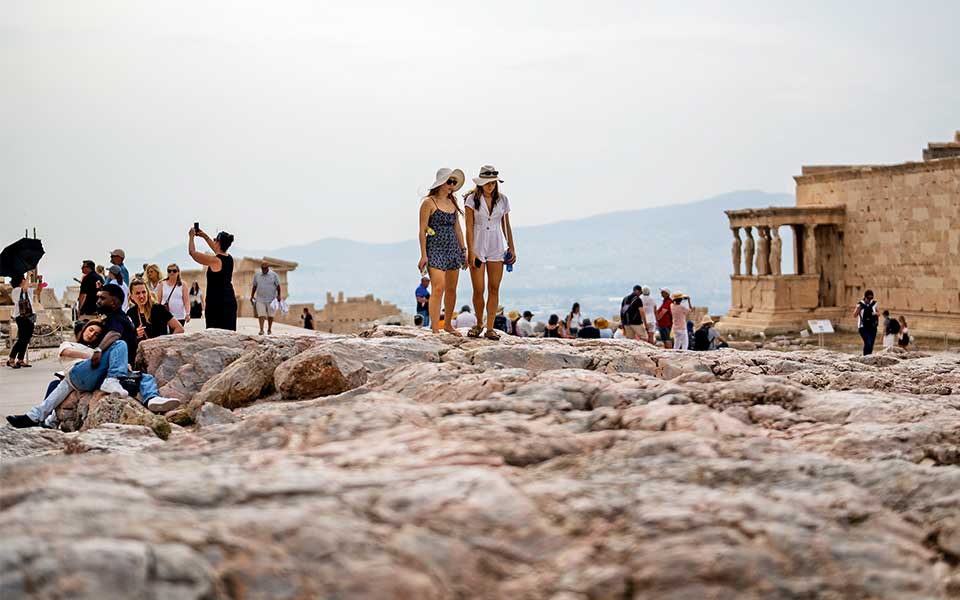Do we, as Athenians, exist in numerous parallel realities? Is this a unique phenomenon or is it an experience we share with the inhabitants of other major cities worldwide? Posing these questions compels me to confront an intriguing dilemma: which aspects of Athens should I share with you? Should I talk of an Athens experiencing a surge in tourism, with more hotels, short-term rental apartments, and consequently longer lines at major cultural attractions such as the Acropolis and its museum? Or should I instead concentrate on the capital’s struggle to reconcile an escalating demand for housing in its central districts with a building inventory overstocked with commercial properties, largely a legacy from the era of extensive post-war reconstruction? Perhaps I should focus on the vibrant cultural and artistic resurgence in a city that’s continually adding new museums, galleries, festivals, and creative collectives to its portfolio.
Should I present Athens as the city that’s hosting Europe’s most extensive ongoing urban renewal? This massive undertaking will transform its once-overlooked southern coastline; it’s a development that might even give birth to a new city within a few years. Alternatively, should I shed light on the persistent issues of daily life in Athens that continue to challenge its residents, despite these large-scale events, the international acclaim, and the glamorous openings? Let’s begin by changing our angle of perception and imagine that we’re observing Athens of 2023 from afar. Even the most pessimistic and sour-tempered Athenian – of which there are many – is willing to concede that post-pandemic Athens is having its moment. This is a peak period that many locals didn’t even witness during the 2004 Olympic Games, when the city had, at least in theory, been spruced up for its star role on the world stage.
The city’s current revitalization was born from the adversity it faced during a decade-long recession, which saw a 25% drop in the country’s GDP, an equally sharp decline in economic indicators, and an exceptional level of “curiosity” from abroad, all of which drastically (and relatively swiftly) reversed Athens’ fortunes. With limited public investment, it was the keen private sector, predominantly within the tourism industry, that was instrumental in the city’s full recovery. As much as the merits and detriments of tourism development are currently up for debate, it’s an indisputable fact that the city’s revival hinged on establishing Athens as an independent tourist destination. This boosted the crisis-ridden city center and, in turn, fostered a new creative community, primarily made up of young people and artists who put down roots in neighborhoods significantly harmed by the difficult period that started in 2010.

© Dimitris Vlaikos

© Perikles Merakos
At present, the city appears to be striving for a new equilibrium. The pitfalls of tourism monoculture are beginning to surface, notably in the form of skyrocketing short-term rentals. This surge is shrinking the supply of available apartments and escalating rental rates, putting significant pressure on middle and lower-income households. However, this is not a phenomenon exclusive to Athens, and it is why all those in power everywhere are currently seeking policies to curb this trend.
The city center of Athens gained popularity swiftly, reminiscent of the surge it experienced during the 2004 Games. However, that popularity was short-lived; it collided with the ensuing debt crisis. No similar threats appear to loom on the horizon today, and the city’s momentum seems unimpeded; we’re witnessing unprecedented developments. One such example is the construction of residential buildings even in Omonia, traditionally a commercial hub with a notoriously problematic reputation and no history of residential use.
The need to revive areas not directly linked to tourism has recently become more apparent. The renovation and expansion plan for the National Archaeological Museum, located not far from Omonia Square, highlights the potential of an Athenian hinterland that was once the stronghold of the middle class. Sadly, this area was neglected after the 1970s when wealthier residents moved to the suburbs.
Finally, after significant delays, the completion of Panepistimiou Street’s regeneration project offers a hopeful sign for a once vibrant part of commercial Athens. This part of the city has been caught up in the touristic boom experienced in other areas. The lingering question is whether this revival will extend to neighboring areas such as Stadiou and Akadimias streets. Stadiou, in particular, which connects the city’s two main squares, is currently witnessing significant investments in iconic buildings that have languished, unexploited, for an extended period. It seems Athens is stirring anew.
While the initial perception may suggest that tourism and real estate are the only industries experiencing growth in Athens, the reality is more complex. After a protracted period of stagnation on the infrastructure front, there is a surge in activity reminiscent of the preparations for the Olympics. Last winter saw the commencement of work on the fourth metro line. In a few months, with the pedestrianization of Vasilissis Olgas Avenue, the unification of the city’s archaeological sites will be complete, forming a vast pedestrian thoroughfare running from Kerameikos to the Panathenaic Stadium. Piraeus, the main port, is witnessing a wave of activity centered around its new metro station and other significant regeneration efforts that are effectively reintegrating it into the metropolitan landscape.

© Perikles Merakos
Concurrently, the start of construction on the new sports facilities for Panathinaikos, the city’s most historic and popular team, in an abandoned area filled with derelict industrial properties in Botanikos, just two kilometers from the city center, gives hope for its revitalization as well. Not far from there, at the site of Plato’s Academy, plans are underway for a new archaeological museum.
The most significant regeneration project on the drawing board, however, is the one that will transform the old Athens airport area. Covering an area of 5,500,000 square meters, this site is set to become, in effect, a new city, complete with a park slightly larger than Hyde Park; the first skyscrapers in the Greek capital boasting both residential and commercial space; detached homes with views of the Saronic Gulf; shopping centers; sports facilities; and a 1,500-meter long beach. The primary project at the old Elliniko airport will stimulate other changes as well; part of the coastal highway will be diverted underground and a number of other primarily tourism-focused investments will be undertaken. The aim is to reintroduce Athens to the world as an unmistakably coastal city.
Despite the surge in construction and investment, Athens is grappling with long-standing maladies. The dismal atmosphere of the 2010s may have receded, but persistent challenges continue to undermine the city’s newfound confidence by impairing the daily quality of life for residents.
Traffic remains Athens’ most significant issue. This is in part attributable to Athenians’ notorious reliance on their private vehicles, but it is mainly due to an inadequate urban transportation network, especially regarding those services, including bus, trolley and tram lines, supplementing the existing three subway lines. The city often has to deal with traffic disruptions due to protests or other public events as well, further straining its residents’ already strained nerves.
At present, instead of being championed, alternative modes of transport, such as bicycles or e-scooters, find themselves increasingly marginalized on hostile roadways. Despite modest advancements, Athens continues to be a somewhat neglected city, plagued by waste, dilapidated buildings, unsafe sidewalks, and sparse greenery. Its roads remain encumbered by parked cars and, in general, it shows little regard for pedestrians. This rather disappointing urban reality hardly befits the capital of a European state. The general spirit of disregard for the law, which some visitors may find intriguing, wrongly equating it with a rebellious sense of freedom uncommon in the rest of Europe, has become a cruel joke for the city’s residents.
Athens often gives the impression that it’s prioritizing its visitors over its residents, appearing to invest more effort in polishing its image than in fixing what really matters, as if it were polishing the facade while ignoring the interior of the house. Yet a model where disgruntled or disillusioned residents seek solace until the early hours in meticulously designed bars, as though they were characters posing for an vacation postcard, cannot sustain itself indefinitely. After all, no one would be drawn to a city where its people seem exhausted or ensnared. We’ve reached a point where Athens must urgently address the problems that lie behind the front door.












